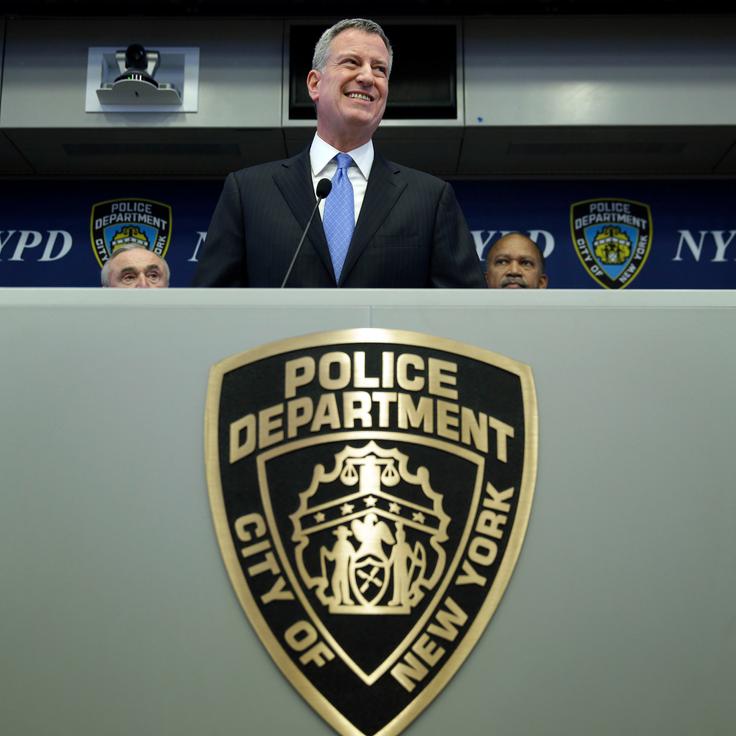A new report alleges that New York City Mayor Bill de Blasio’s crackdown on gangs is so overreaching and ill-defined, that he has effectively revived the same discriminatory policing practices he slams his predecessor for.
The report, compiled by the Policing and Social Justice Project at Brooklyn College, accuses de Blasio’s New York City Police Department of targeting Black and brown communities with militarized takedowns by vaguely associating them with gangs. The college released its findings ― titled “Gang Takedowns in the de Blasio Era: The Dangers of ’Precision Policing” ― as the mayor continued to publicly criticize former city mayor and current 2020 presidential candidate Michael Bloomberg for the now-defunct stop and frisk policy.
Authors Josmar Trujillo and professor Alex Vitale say the NYPD has cobbled together policies that allow it to classify Black and brown youth as possible gang members using red flags that might be as simple as a kid wearing certain clothing or using slang. And under de Blasio, the number of young men being classified as gang members in non-white communities is skyrocketing.
“The decision to frame the crime problems in certain communities as a gang problem is a political one,” said Vitale on Thursday. He added that the report is calling on the mayor to “switch to real, community-based social services that try to treat young people with respect.”
He said de Blasio’s tactics aren’t much different than those deployed in the stop and frisk era, a time in which many non-white New Yorkers were frivolously searched and arrested without warrants or probable cause. Bloomberg had popularized “stop and frisk” throughout his time in office from 2003-2013, and he recently apologized for the role his policy played in rampant racial profiling throughout the city.
But under de Blasio, Trujillo and Vitale write, “the NYPD is merely substituting one set of techniques to tightly manage the lives of young people of color for another.” According to the authors, stop and frisk has given way to an equally-intrusive, far more insidious strategy of profiling.
The authors interviewed arrested New Yorkers and their families, news reports, police documents and officers’ accounts to paint a picture of a department committed to making arrests ― in many cases, flimsy ones ― in predominantly Black and brown schools and neighborhoods. The report also notes an eagerness among officers to classify amorphous groups of Black and brown people as gangs while declining to do the same with violent white supremacist groups that have grown in popularity in New York City over recent years.
“The police department has said that the white nationalist group Proud Boys, who describe themselves as a gang, are not in the [gang] database and refuse to acknowledge whether traditional Mafia organizations are included,” the report says.
According to the report, the NYPD’s database of purported gang members was roughly 90 percent Black and Hispanic during Bloomberg’s time as mayor, from 2003 to 2013. Over the following five years ― mostly under de Blasio ― the rate of people entered the gang database rose 70 percent, and the percentage of Black and Hispanic people in the database rose to 98 percent, the data show.
Trujillo and Vitale also report that the NYPD uses uncertain and troubling ways to classify someone as a “gang member.”
Police might add someone’s name to the gang database if two “independent sources” identify the person as a gang member, the report states. But those can be people who work closely with police or Department of Corrections officers, who may use the same imprecise definition of gangs used by the NYPD. Sources are instructed to note “trouble with police” as a sign of potential gang activity, an identifier which might include millions of people in a city with as fraught a policing history as New York.
Another reason officers add a name to the database, for example, is when a citizen they’re interviewing claims they’re a gang member. But the authors note that some children exaggerate gang membership to grandstand.
“Bragging and overstating one’s position in a gang, the legitimacy of a gang (i.e. a group of friends that calls themselves a ‘gang’) or claiming that one’s crew of friends is tough or rich can be based less on reality and more on a fictional projection for those who seek value in street culture,” they write.
Any combination of these traits might land someone in the NYPD’s gang database: gang-related scars or tattoos; wearing gang-related colors; associating with known gang members; making hand signs associated with gangs; or being seen in “known gang locations.”
But the classification of “known gang locations” is also tainted with racial bias, the report says.
“Since most of the areas marked as gang territories by the NYPD are areas with higher concentrations of Black and Latinx populations, a ‘known gang location’ (fulfilling half of the criteria towards gang designation) can serve as a proxy for race,” it says.
The authors interviewed residents living in various housing developments and reviewed news reports of high-profile-but-fruitless “gang busts” to show officers are frequently misguided in their searches.
For its part, the NYPD says those added to the database have ways to get taken off ― but the onus is on them to prove they’re not a gang member. In a statement to HuffPost, the NYPD said:
“The Department has created three avenues to exit the database, reviewing each person every three years, and on their 23rd and 28th birthdays to determine if their actions and records still warrant their inclusion in the database. These safeguards are robust. In the last four years, we have removed over 3,700 entries from the database using these exit ramps.”
Trujillo and Vitale’s report is the latest in a string of police-related critiques that have been lobbed toward the de Blasio administration. Police reform activists have decried what they perceive to be a lack of urgency on matters of police misconduct. The activists’ dissatisfaction came to a head when they claimed the mayor was slow to respond to the death of Eric Garner in 2014, who was killed after being placed in a chokehold by former officer Daniel Pantaleo.
De Blasio has continued to bill himself as a sympathetic party when it comes to racial inequality and racial profiling. He has frequently invoked his Black son to suggest the problem of policing disparity affects his home, as well.
His office didn’t immediately respond to calls for comment on the report.

